Howard Andrew Jones's Blog, page 44
June 12, 2015
Swords in the Mist Re-Read: “Lean Times in Lankhmar”
 Bill Ward and I are continuing our read through of Fritz Leiber’s collection of Fafhrd and Gray Mouser stories, Swords in the Mist. This week we’re looking at the second tale in the collection, “Lean Times in Lankhmar.”
Bill Ward and I are continuing our read through of Fritz Leiber’s collection of Fafhrd and Gray Mouser stories, Swords in the Mist. This week we’re looking at the second tale in the collection, “Lean Times in Lankhmar.”
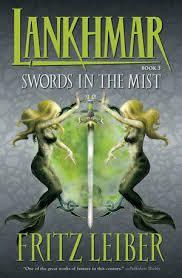 Howard: This is probably the funniest Fafhrd and Gray Mouser story in the entire canon, and likely the funniest sword-and-sorcery tale ever written that isn’t supposed to be a farce or a send-up. The only other tale by a famed sword-and-sorcery writer that comes close is Robert E. Howard’s “Gates of Empire,” which also is flat-out hilarious… but as it’s historical and free of supernatural elements I guess it’s not an apple to apple comparison.
Howard: This is probably the funniest Fafhrd and Gray Mouser story in the entire canon, and likely the funniest sword-and-sorcery tale ever written that isn’t supposed to be a farce or a send-up. The only other tale by a famed sword-and-sorcery writer that comes close is Robert E. Howard’s “Gates of Empire,” which also is flat-out hilarious… but as it’s historical and free of supernatural elements I guess it’s not an apple to apple comparison.
Bill: You’re not kidding, I was snickering, snorting, and guffawing my way all the way through.
Howard: I can recall reading this multiple times and laughing out loud again and again each time I did so. Alas, even after nearly a quarter century away from the story I remember it too well to be completely delighted now, so I have to instead take pleasure in the careful build-up to the climax. Everything in the tale is setting us up for the grand finale — Fafhrd’s re-appearance in changed form, howling for the final jug of wine.

Fritz Leiber
Bill: The climax slipped my mind until the moment the Mouser started getting Fafhrd drunk at the end, then it all came back to me.
Howard: Surely this is not just the funniest of the Fafhrd and Mouser stories, but one of the very strongest as well. A lot of the humor comes from being familiar with the characters and how they would normally act, but I’ve a sneaking suspicion that Leiber’s done such a fine job here that even someone unfamiliar with them would enjoy this outing.
Bill: I think so, too. Leiber is great at both the character-based humor, and also an overall narrative humor that’s part voice, part clever prose, and all about Leiber’s keen wit and outlook on the world.
Howard: It’s also interesting to see how they fare when away from each other. Not so well, as it turns out: like any great team, they’re stronger together than apart, with each becoming absorbed in matters that lead them to unhealthy habits — Mouser, grown soft with sensual pleasures, and Fafhrd with his head too high in religious clouds.
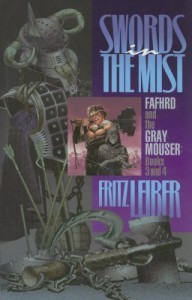 Bill: It’s wonderful that they both take opposite paths to basically get to the same point. Again and again it’s these great character moments (to echo what you just said, we have a scene where Fafhrd labors over the creation of a devotional object while the Mouser sizes up a street waif), and Leiber’s characterization in general, that is so wonderful. Fafhrd was as sincere about his religious awakening as the Mouser was cynical. Even at the very end some of Fafhrd’s serious, poetical self comes through when, in referencing the hilarious climax of the story in which a drunk, shaved, and bound Fafhrd is taken by a horde of worshipers as their god returned to earth, he says to Mouser that he really was that god.
Bill: It’s wonderful that they both take opposite paths to basically get to the same point. Again and again it’s these great character moments (to echo what you just said, we have a scene where Fafhrd labors over the creation of a devotional object while the Mouser sizes up a street waif), and Leiber’s characterization in general, that is so wonderful. Fafhrd was as sincere about his religious awakening as the Mouser was cynical. Even at the very end some of Fafhrd’s serious, poetical self comes through when, in referencing the hilarious climax of the story in which a drunk, shaved, and bound Fafhrd is taken by a horde of worshipers as their god returned to earth, he says to Mouser that he really was that god.
Howard: Great point. That was a fine ending, as well.
There are subtle satiric touches among the broad comic ones, such as comments on human nature and the allure of religion as well as prophets, and even, despite all the comedy, some action and adventure and some creepy supernatural elements with the mention, then “appearance” of the Gods OF Lankhmar.
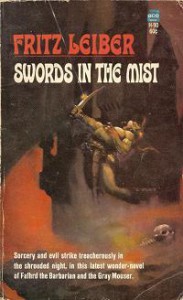 Bill: Indeed, and that’s one thing that is so amazing about these stories when they are at their best — they maintain a perfect balance between the serious and the humorous. After spending ten-thousand words on corrupt, imaginary, silly, bizarre, and contemptible religious cults we are treated to a blast of cold water in the form of the black bones of the true Lankhmarese gods. I don’t think anyone will be stealing their offering cask and replacing it with brandy anytime soon. Just as Leiber injects the serious with humor, he also does the reverse, and I think that’s a big part of why these tales have such a reality about them, and the characters are so vivid and so loved by fans.
Bill: Indeed, and that’s one thing that is so amazing about these stories when they are at their best — they maintain a perfect balance between the serious and the humorous. After spending ten-thousand words on corrupt, imaginary, silly, bizarre, and contemptible religious cults we are treated to a blast of cold water in the form of the black bones of the true Lankhmarese gods. I don’t think anyone will be stealing their offering cask and replacing it with brandy anytime soon. Just as Leiber injects the serious with humor, he also does the reverse, and I think that’s a big part of why these tales have such a reality about them, and the characters are so vivid and so loved by fans.
Also, as a final aside, I loved that one of the possible falling out points between our heroes was the spelling of Fafhrd’s name — you and I both have stumbled over that “mouth-filling agglomeration of consonants” many times while discussing these stories!
Howard: …and likely will again. You’ve corrected my spelling of Fafhrd at least twice. Well, that’s it for this week. I hope, even if you haven’t been reading ALL of our selections, that you tried this one. Next time, “Their Mistress, the Sea.” I’ve little recollection of this one, but I’m afraid it may be one of the “filler” episodes Leiber added later. I hope I’m wrong. So far, this collection is two thumbs way up.
June 10, 2015
The Perfect Pocket Writing Notebook: Review 4
 This week I’m looking at the Poppin Soft Cover notebook. In previous reviews I’ve simply mentioned that a product is widely available without providing a link because I’m pretty sure you all know how the search function works. (If you’ve questions about my criteria, that preceding link should take you to a page than answers them.)
This week I’m looking at the Poppin Soft Cover notebook. In previous reviews I’ve simply mentioned that a product is widely available without providing a link because I’m pretty sure you all know how the search function works. (If you’ve questions about my criteria, that preceding link should take you to a page than answers them.)
In the case of Poppin, though, the notebook is currently only available through the manufacturer, so you’ll probably have to pay shipping costs. And that’s okay, because even with shipping the Poppin is a bargain. Here’s the link.
Price: $6.00
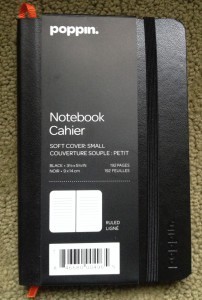 Currently the pocket Poppin notebook is only available as a softcover, and comes in a raft of colors, as shown above.
Currently the pocket Poppin notebook is only available as a softcover, and comes in a raft of colors, as shown above.
Other manufacturers reserve the term “Cahier” to refer to a slim, staple-bound notebook. The Poppin has sewn bindings, however, like all other pocket notebooks on my “best” list. I hadn’t seen the pocket model reviewed anywhere else, so I decided to road test its durability myself. It’s holding up very well. Use has given mine a few cover dings, which may be visible in the photos.
The soft cover means that it’s quite flexible. It comes with a dedicated spot on the inside front cover for name and contact information.
The cover’s surviving me taking it in and out of my pocket multiple times a day, and so are the pages. And speaking of pages, the Poppin softcover has a really striking format that makes it unique among all of its competitors.
 I like that line arrangement a lot. I hope its designer got a pat on the back, and hopefully a raise. There’s a dedicated space for identifying what’s on the page at the top, or numbering items along the side, or creating a table of contents, something I find useful once I’ve filled the notebook and am later searching through it. All in all the formatting is just a great organizational tool and one of this model’s strong points. The only room for improvement I could see would be the addition of page numbers like its competitor, the Leuchtturm1917, although that might require expense that would lose that attractive price point.
I like that line arrangement a lot. I hope its designer got a pat on the back, and hopefully a raise. There’s a dedicated space for identifying what’s on the page at the top, or numbering items along the side, or creating a table of contents, something I find useful once I’ve filled the notebook and am later searching through it. All in all the formatting is just a great organizational tool and one of this model’s strong points. The only room for improvement I could see would be the addition of page numbers like its competitor, the Leuchtturm1917, although that might require expense that would lose that attractive price point.
With its durability, good manufacture, low price point, flexibility, and formatting, the Poppin makes for an excellent writing notebook. Yes, I took it on a road test because I wanted to be able to report upon its durability. But I also wanted to get to work in it as soon as possible.
June 8, 2015
Notebook Writing
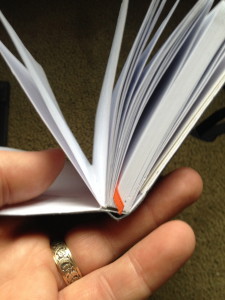 One of the reasons I’ve been talking about writing notebooks so much lately is that I’ve been using them more than ever.
One of the reasons I’ve been talking about writing notebooks so much lately is that I’ve been using them more than ever.
It’s just too danged easy to be distracted while on a computer and lately I’ve been extra distractible. E-mail checking, looking up data that I didn’t have any interest in a few moments before, following links from Facebook to articles I didn’t know I wanted to read, etc. I’ve been failing the Dr. McCoy test pretty miserably. Sometimes I promise myself I won’t be distracted and get good work done, and sometimes I fall prey to Resistance.
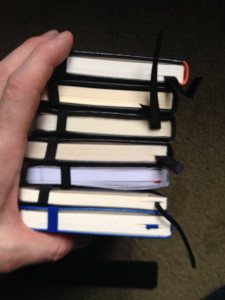 To break up the routine I’ve taken to writing the rough draft in longhand in my notebook and then punching it up as I type it in. I don’t do it ALL the time, or even half of the time, but I do it every few days just to break things up a little and get away from the computer. Varying the process has seemed to help, along with my revised outlining method. If I’m writing in the notebook I’m a LOT harder to distract, at least for now. I’m sure that as with most writing tips I’ll find that there are exceptions, but the important thing is that this solution is working NOW, so maybe this trick will help you, at least sometimes.
To break up the routine I’ve taken to writing the rough draft in longhand in my notebook and then punching it up as I type it in. I don’t do it ALL the time, or even half of the time, but I do it every few days just to break things up a little and get away from the computer. Varying the process has seemed to help, along with my revised outlining method. If I’m writing in the notebook I’m a LOT harder to distract, at least for now. I’m sure that as with most writing tips I’ll find that there are exceptions, but the important thing is that this solution is working NOW, so maybe this trick will help you, at least sometimes.
It also means I’m filling the notebook up a lot faster, which is the only downside. Fortunately I happen to have a lot of pocket notebooks lying around these days if I fill one up early…
June 5, 2015
Swords in the Mist Re-Read: “The Cloud of Hate”
 Bill Ward and I are reading another collection of Fritz Leiber’s Lankhmar stories, Swords in the Mist. This week we’re starting with the first story in the collection, “The Cloud of Hate.” We hope you’ll grab a copy and join in.
Bill Ward and I are reading another collection of Fritz Leiber’s Lankhmar stories, Swords in the Mist. This week we’re starting with the first story in the collection, “The Cloud of Hate.” We hope you’ll grab a copy and join in.
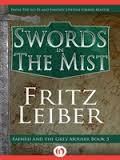 Howard: Maybe this isn’t quite top drawer Lankhmar, but it’s darned close. This is a strong start to the collection. If Leiber wasn’t in competition with the very best of his own writing, I’d number this as one of the better sword-and-sorcery tales I’ve ever read.
Howard: Maybe this isn’t quite top drawer Lankhmar, but it’s darned close. This is a strong start to the collection. If Leiber wasn’t in competition with the very best of his own writing, I’d number this as one of the better sword-and-sorcery tales I’ve ever read.
Bill: Well, that’s always the thing, isn’t it? I don’t hesitate to call Leiber or (our last read-along subject for those of you who may not know) Dunsany geniuses, but when you’ve got to analyze their work they are going to face some tough comparisons — with themselves. That said, this is a great little gem, a compact story full of beautiful language, rich and inventive details, and fun banter between our heroes.
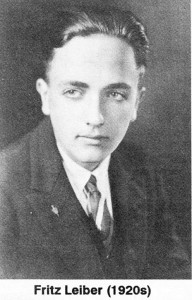 Howard: Oddly enough, I think the best scenes in the story are between all the other characters rather than Fafhrd and the Mouser themselves. Leiber does a fantastic job growing the dread of the evil cloud, starting with his description of the underground temple where the thing is generated. I’ve no idea how many times I ran role-playing games after this where my players walked into similar temples with oddly spaced columns.
Howard: Oddly enough, I think the best scenes in the story are between all the other characters rather than Fafhrd and the Mouser themselves. Leiber does a fantastic job growing the dread of the evil cloud, starting with his description of the underground temple where the thing is generated. I’ve no idea how many times I ran role-playing games after this where my players walked into similar temples with oddly spaced columns.
Bill: That’s great! It’s amazing how a little detail like that can inspire a person. They do just seem to spark something in the imagination. And there is something much more sinister about oddly-spaced columns, it’s immediately alien.
I think it’s safe to say at this point that one of the common threads of the Lankhmar stories is possession — many times we’ve seen our heroes or others lose control of themselves and follow the compulsion of another. The great imagery of this hate fog rising up collectively out of an evil cult is a new spin, our heroes being immune to it for a change is a nice look at just how far above some of the other more extraordinary denizens of Lankhmar they stand. Indeed, one of my favorite things about the story is how each of our heroes rejects the cloud — Fafhrd isn’t really a hateful person and the Mouser is so self-absorbed he just can’t bear not to be the “source of his own evil.”
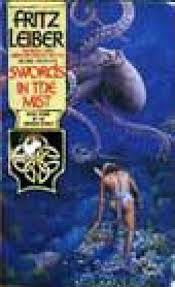 Howard: I missed that “possession” angle. That’s a really good observation. I wonder if me reading and re-reading these stories isn’t one of the reasons I’ve had to fight possession as a theme in my own fiction. It cropped up once in a major way and I’ve tried not to revisit it.
Howard: I missed that “possession” angle. That’s a really good observation. I wonder if me reading and re-reading these stories isn’t one of the reasons I’ve had to fight possession as a theme in my own fiction. It cropped up once in a major way and I’ve tried not to revisit it.
The rejection of the cloud by our heroes may be the single best moment in the tale; it’s telling about who they really are.
Bill: For me, these little character moments are the things I really delight in, and between the friendly bickering around the brazier, and the fight where Mouser exhibits his knowledge of the underworld to his advantage and Fafhrd shows a talent for tactical improvisation, we get those little moments in spades.
Howard: Oh yeah, the fight is brilliant. Even though I knew they were going to get through it okay, there’s so much dread built up as the cloud recruits its minions that it was thrilling to see how they fought their way to the end. And the moment when the cloud reaches for the discarded weapons was still creepy as hell, even though I remembered it was going to happen.
Next week, one of the very best of all the Fafhrd and Gray Mouser tales, “Lean Times in Lankhmar.” Hope to see you here!
June 3, 2015
The Perfect Pocket Writing Notebook: Review 3
 This week I’m reviewing the Rhodia Web Notebook. Although its referred to by some as the “webbie” you’ll never hear me say that aloud. For previous pockect writing notebook reviews or my criteria, click here.
This week I’m reviewing the Rhodia Web Notebook. Although its referred to by some as the “webbie” you’ll never hear me say that aloud. For previous pockect writing notebook reviews or my criteria, click here.
Pricing: $15.25 and up
The Rhodia Web Notebook is on the high end of pocket notebooks, which means that once shipping is added in it’s pretty much priced out of my criteria (and yes, there are some pocket notebooks that are even more expensive).
Although sometimes expensive products aren’t obviously superior to their competitors in any way, the Web Notebook clearly has high production values, which may explain its devoted legion of followers.
The pocket Web Notebook is hardback and comes in basic black and terrifying orange and is allegedly manufactured in other colors besides. It’s widely available, as a search for Rhodia Web Notebook, Pocket (or A6) will show you, with prices varying by site.
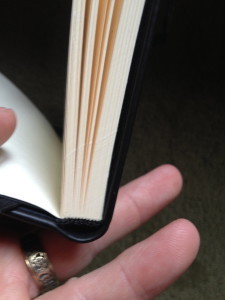
Look at the excellent binding!
What you won’t be able to tell from any images is just how pleasant the cover feels. Though hardback, it’s slightly flexible and has a little give to it besides, providing a nice tactile sensation when you grip it. The binding isn’t just solid, it’s extremely well put together.
Inside, the pages have a warm, creamy coloration and are allegedly wonderful for fountain pens, which is another reason for the Rhodia’s higher expense (I don’t use fountain pens, so I don’t know, but a lot of fountain pen users gush about the Rhodia Web Notebook). I’m a plain old ballpoint pen user myself, yet even I can see the attraction of the paper.
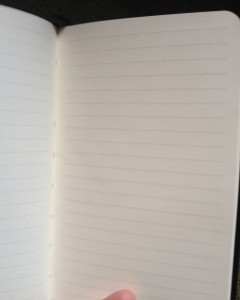
A look inside.
It has no real frills other than its outstanding production values. It does come emblazoned with the company logo smack dab in the middle of the cover, which I find a little much, and the cover retains marks from the closure when you remove the elastic band, which some might find off-putting (I didn’t — marks and scuffs add character). I suppose I should mention that I find its lines just a little light, something my teenaged daughter remarked upon as a problem. On the other hand, it might be seen as a feature because the lines are dark enough to use as a guideline but don’t stand out starkly.
I wish there was a little extra space up at the top, but some people prefer as many lines as possible. I will point out that the lines are well spaced so that there’s no unusable ones, as you’ll find in 2015 era Moleskines. It’s durable and is, simply, one of the best made pocket notebooks on the market. In this instance, one old adage is certainly true: you definitely get what you pay for.
June 1, 2015
New Outlining Thoughts
 Just last year I was pretty firmly convinced I had an outlining method that was working perfectly. To be honest, it HAD worked pretty well. It saw me through the composition of two new Pathfinder novels that I’m pleased with.
Just last year I was pretty firmly convinced I had an outlining method that was working perfectly. To be honest, it HAD worked pretty well. It saw me through the composition of two new Pathfinder novels that I’m pleased with.
As with any writing method I’ve ever used, though, I’ve discovered that it doesn’t work in every instance. Sometimes what looks good in an outline doesn’t work as well when I set it down on paper.
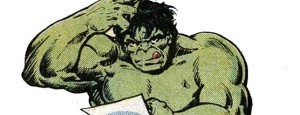 I’ve been experimenting with a modified version of my outlining method and it seems to be working for me currently. I work from a rough overall outline — I know what happens in the end, of course, and I know the next plot point the characters are going to reach. What I don’t have is every point between the next one and the end already figured out before I start writing (although naturally I have a few ideas).
I’ve been experimenting with a modified version of my outlining method and it seems to be working for me currently. I work from a rough overall outline — I know what happens in the end, of course, and I know the next plot point the characters are going to reach. What I don’t have is every point between the next one and the end already figured out before I start writing (although naturally I have a few ideas).
Rather than working out the entire plot before I start, I work out the villain’s motives and the major arcs (and conclusion) then figure it out plot point to plot point. Every time I get a new section written in prose form I work out the next part by jotting something that’s mid-way between an outline and a rough draft (sometimes slipping into play dialogue format, which still works very well for me). Once that feels right, then I turn it into a draft.
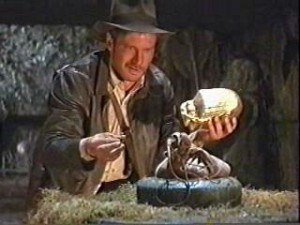 As an illustration I’d usually turn to Raiders of the Lost Ark, but given that in a recent writer’s talk a third of the audience had never seen the film (I know, right?), I’ll try it with something more recent. Say I had been the writer of the first Avengers movie. While outlining it, I would know that the aliens would come through at the end thanks to Loki’s machinations, and I might know that Coulson was going to die, but I probably wouldn’t know how it would all work out. Suppose that I’d written a draft I was fairly happy with up to the point all our heroes got on the helicarrier. I’d know that the next plot point would be the capture of Loki, so I’d sit down and plot that out, then write it.
As an illustration I’d usually turn to Raiders of the Lost Ark, but given that in a recent writer’s talk a third of the audience had never seen the film (I know, right?), I’ll try it with something more recent. Say I had been the writer of the first Avengers movie. While outlining it, I would know that the aliens would come through at the end thanks to Loki’s machinations, and I might know that Coulson was going to die, but I probably wouldn’t know how it would all work out. Suppose that I’d written a draft I was fairly happy with up to the point all our heroes got on the helicarrier. I’d know that the next plot point would be the capture of Loki, so I’d sit down and plot that out, then write it.
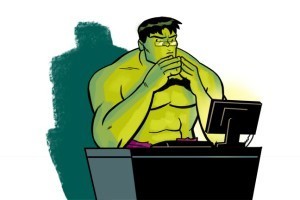 Assuming I knew immediately which was the right way to go (Loki’s escape) I’d next start outlining toward that scene. Of course if I was feeling inspired about some later moment — say Cap’s brave tactical stand in the streets of New York — I might just write that down. These days I never feel constrained to stay in a scene or a chapter if I’m feeling inspired about something that takes place later. I make sure I get it down.
Assuming I knew immediately which was the right way to go (Loki’s escape) I’d next start outlining toward that scene. Of course if I was feeling inspired about some later moment — say Cap’s brave tactical stand in the streets of New York — I might just write that down. These days I never feel constrained to stay in a scene or a chapter if I’m feeling inspired about something that takes place later. I make sure I get it down.
Anyway, there’s what I’m doing now. Hope you find it of use!
May 29, 2015
Swords Against Death Re-Read: Conclusion
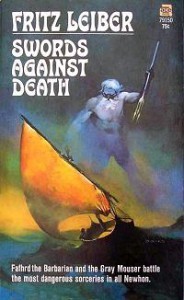 Over the last two months Bill Ward and I have been sharing our thoughts about one of my favorite short story collections, and the first sword-and-sorcery fiction I even encountered, Fritz Leiber’s Swords Against Death.
Over the last two months Bill Ward and I have been sharing our thoughts about one of my favorite short story collections, and the first sword-and-sorcery fiction I even encountered, Fritz Leiber’s Swords Against Death.
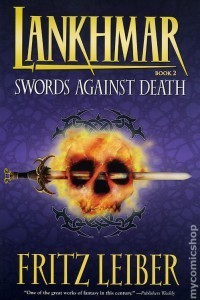 Howard: I was afraid that it wouldn’t hold up, and I was delighted to find that my worries were wrong. At his best, Leiber stands at the pinnacle of his profession and I see now why even writers like Michael Moorcock and Harlan Ellison speak of his work with a little awe. The Lankhmar stories are uneven overall, but there are no real stinkers in this particular collection, and more than half are very strong to excellent.
Howard: I was afraid that it wouldn’t hold up, and I was delighted to find that my worries were wrong. At his best, Leiber stands at the pinnacle of his profession and I see now why even writers like Michael Moorcock and Harlan Ellison speak of his work with a little awe. The Lankhmar stories are uneven overall, but there are no real stinkers in this particular collection, and more than half are very strong to excellent.
My favorite, hands down, was “Bazaar of the Bizarre.” It’s essential reading for any adventure writer. I think you could read that short tale ten times and still find new things to marvel about.
In order of my preference, I rank the tales of the collection as follows.
1. Bazaar of the Bizarre
2. The Seven Black Priests
3. Thieves’ House
4. The Sunken Land
5. The Jewels in the Forest
6. The Howling Tower
7. The Bleak Shore
8. The Price of Pain-Ease
9. The Circle Curse
10. Claws from the Night
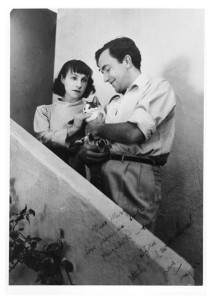
Jonquil & Fritz Leiber.
I think the biggest surprise for me was how far “Claws from the Night” dropped in my estimation. Going by memory I would have placed it as a solid mid-level entry, but apart from a few high points I thought it a minor story in the Lankhmar saga, and it certainly pales in comparison to “Bazaar.” Speaking of which, I’d thought “Bazaar” equally good with several others, and was astonished to discover just how excellent it truly was, supplanting even the one I’d thought my favorite, “The Seven Black Priests.”
The only other surprises were a new appreciation for “The Circle Curse,” which I no longer despise even if I find it something less than fully realized, and “The Price of Pain-Ease,” which I’d more or less forgotten.
Bill: I’ve read these stories much more recently than you have, so I didn’t really expect to be revising any opinions. If anything, I just like Leiber even more now, and I think I’d go so far to say that his work represents the peak of classic sword and sorcery. The first time I read all of these stories I devoured them, all seven books, more-or-less one after the other. Reading them again, and reading at most maybe two stories a week, just further highlights Leiber’s remarkable skill — these are stories to savor. Possibly the only real surprise I had was how well I remembered certain images or events in these stories, and on more than one occasion I realized that I was encountering the direct inspiration for a story of mine. I’d say I also have a much better idea now of how Leiber put all these stories together, and just how his writing chronology differs from the career chronology of the characters.
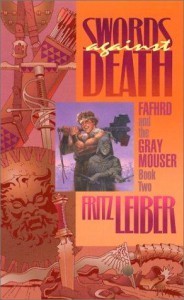 I’ve never been great at ranking things, but my preferences are roughly the same as yours. “Bazaar” has always been my favorite Fafhrd and Gray Mouser story, or at least it’s in the top three spots. The stories that were written later do seem to be our least favorites (and I really think this has to do, in part, with their juxtaposition with earlier pieces), and I’m still not certain how I feel about Leiber going back and shaping the saga with origin stories and adding the arc of the dead lovers — not because there is anything at all wrong with any of the elements, but more because of the stylistic and tonal shifts. It does make an interesting contrast with Howard’s own approach with Conan, and a big difference of course is that Leiber wrote these stories over a period that was longer than Howard’s entire lifetime. But, if anything, this just makes me curious to read the three novellas of “Swords and Deviltry” again.
I’ve never been great at ranking things, but my preferences are roughly the same as yours. “Bazaar” has always been my favorite Fafhrd and Gray Mouser story, or at least it’s in the top three spots. The stories that were written later do seem to be our least favorites (and I really think this has to do, in part, with their juxtaposition with earlier pieces), and I’m still not certain how I feel about Leiber going back and shaping the saga with origin stories and adding the arc of the dead lovers — not because there is anything at all wrong with any of the elements, but more because of the stylistic and tonal shifts. It does make an interesting contrast with Howard’s own approach with Conan, and a big difference of course is that Leiber wrote these stories over a period that was longer than Howard’s entire lifetime. But, if anything, this just makes me curious to read the three novellas of “Swords and Deviltry” again.
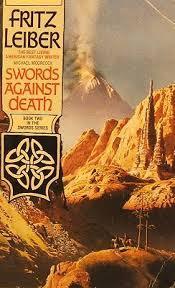 Howard: When we finished our first Lord Dunsany book I was eager to move on to more by him, and I’m feeling the same with Leiber. These were just so much fun that I want to keep going. I hope we don’t suffer from Leiber fatigue as we did with Dunsany.
Howard: When we finished our first Lord Dunsany book I was eager to move on to more by him, and I’m feeling the same with Leiber. These were just so much fun that I want to keep going. I hope we don’t suffer from Leiber fatigue as we did with Dunsany.
Bill: I want to say there’s no such thing as Leiber fatigue, but let’s find out.
Howard: I have very fond memories of “The Cloud of Hate” and “Lean Times in Lankhmar.” They were composed at about the same time as the high water mark “Bazaar of the Bizarre,” so it will be interesting to see if they, too, are Leiber at his very best.
May 27, 2015
The Perfect Pocket Writing Notebook: Review 2
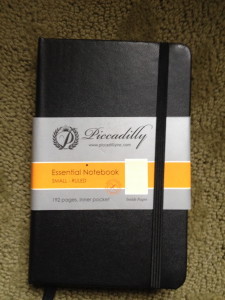 This week I’m reviewing the Picadilly Essential Notebook. If you want to take a closer look at my criteria (starting with the fact that all of the pocket notebooks on my “best of” list have to be approximately 3.5 by 5.5 inches) click here, and if you want to see all my posts on pocket writing notebooks, click here.
This week I’m reviewing the Picadilly Essential Notebook. If you want to take a closer look at my criteria (starting with the fact that all of the pocket notebooks on my “best of” list have to be approximately 3.5 by 5.5 inches) click here, and if you want to see all my posts on pocket writing notebooks, click here.
Pricing = $2.60 and up
The Picadilly may not have the features of some of my other “best of” notebooks, and it may not be as finely made as others, but it’s made well enough, and at its low price it’s an incredible bargain. Even if you have to pay a few dollars for shipping it’s probably going to cost you less than any other one of my top notebooks prior to paying their shipping cost.
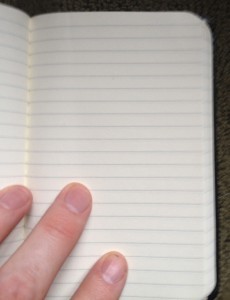 The Picadilly is no frills, but, really, what frills to you need? It lays flat. It has the standard features like a bookmark and a storage envelope built into the inside back cover, as well as an elastic closure strap. The lines are well spaced so that you can write all the way to the top, which many prefer. I personally like just a little room up top to create headers when I need them — to aid with finding information later — but your own mileage may vary.
The Picadilly is no frills, but, really, what frills to you need? It lays flat. It has the standard features like a bookmark and a storage envelope built into the inside back cover, as well as an elastic closure strap. The lines are well spaced so that you can write all the way to the top, which many prefer. I personally like just a little room up top to create headers when I need them — to aid with finding information later — but your own mileage may vary.
It apparently comes in a softback as well as a hardback, but the softback, as of May 2015, isn’t as easily available in my area. It’s manufactured in other colors besides black, although right now they’re a little harder to find, or are more expensive.
The hardback isn’t as flexible as some competing brands, and the binding isn’t quite as nice, and like several more expensive brands, the cover retains marks from the elastic closure (I’ve never thought it a big deal). But it’s a solid, durable little notebook. If it were going head to head with other brands at a mid-range cost like $12 dollars, it would be outclassed. But at this low price it’s a scrappy little contender.
May 25, 2015
Link Monday
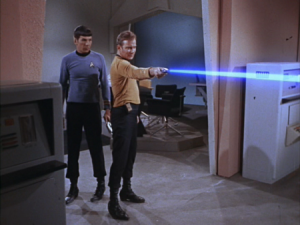 Sooner or later Hardboiled Monday’s going to slide back around the corner and tip up its fedora, but for now, here are some links I found interesting.
Sooner or later Hardboiled Monday’s going to slide back around the corner and tip up its fedora, but for now, here are some links I found interesting.
First, here’s a nifty kickstarter for an anthology of fantasy stories assembled by the talented Marc Tassin, and crammed with gifted writers. Check it out.
Second, for role-playing fans, here’s a kickstarter for some great looking sword-and-sorcery adventures from the creator of Astonishing Swordsmen and Sorcerers of Hyperborea (incidentally, it’s marked down at RGPNow through the month of May). If you’re not familiar with AS&SH then you must not have been reading my blog for long. It does a great job of bringing the sword-and-sorcery vibe to Dungeons & Dragons.
Finally, Star Trek fans, I’ve found an excellent essay on why Captain Kirk is an inspiring leader. Well, I think it’s excellent, because it echoes everything I said here and expands upon it. It specifically references the same problems I had with Kirk in the Trek reboot movies. Enjoy.
May 22, 2015
Swords Against Death Re-Read: “Bazaar of the Bizarre”
 Bill Ward and I are re-reading a book from Fritz Leiber’s famous Lankhmar series, Swords Against Death. We hope you’ll pick up a copy and join us. This week we tackled the tenth and final tale in the volume, “Bazaar of the Bizarre.”
Bill Ward and I are re-reading a book from Fritz Leiber’s famous Lankhmar series, Swords Against Death. We hope you’ll pick up a copy and join us. This week we tackled the tenth and final tale in the volume, “Bazaar of the Bizarre.”
Bill: Let me just say right at the outset that this is one of the all time great fantasy titles — long before I’d ever read Leiber, I knew the title “Bazaar of the Bizarre” (from, I think, Dragon magazine) and it turned out to be the first story of Fafhrd and the Gray Mouser I’d ever read, in some since-forgotten anthology, and I still remember the anticipation leading up to it. I wasn’t disappointed.
 Howard: I’d remembered this one was strong, but I’d forgotten just how strong, or perhaps I just hadn’t had enough critical acumen to judge. It’s head and shoulders above even the very finest of the stories we’ve already read: “Bazaar of the Bizarre” is simply pitch perfect from first sentence to last. On the surface a “mere” tale of light adventure, “Bazaar” is a perfectly executed gem. I see now why it’s been chosen to be included in anthologies so many times, and why Fritz Leiber himself thought it one of his best.
Howard: I’d remembered this one was strong, but I’d forgotten just how strong, or perhaps I just hadn’t had enough critical acumen to judge. It’s head and shoulders above even the very finest of the stories we’ve already read: “Bazaar of the Bizarre” is simply pitch perfect from first sentence to last. On the surface a “mere” tale of light adventure, “Bazaar” is a perfectly executed gem. I see now why it’s been chosen to be included in anthologies so many times, and why Fritz Leiber himself thought it one of his best.
Bill: Everything these stories do well is here done perfectly.
Howard: If I were to cite every standout sentence in the story and explain it, I think the essay would be at least as long as the story itself. In “Bazaar” Leiber’s reached his mature tone but doesn’t over reach, as I might argue he did with “Pain-Ease” from last week. There’s beautiful poetic imagery, but it doesn’t stray and meander. There’s fantastic imagination , but it’s perfectly controlled. And the characters are front and center being their wonderful idiosyncratic selves.
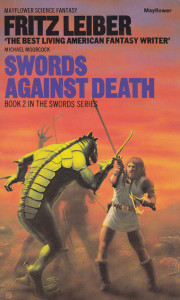 How about that second paragraph, where the vendors and peddlers “conduct their business almost as silently as the stars conduct theirs?” A first sign of the well-turned phrases that were to lie gleaming like fountain coins throughout this story. Long phrases, wonderful dialogue, even short descriptions (like “the garishly bright shop with its doorway like an upended heart) are all so crystal clear and vivid that I almost want to hang my head in shame for daring to be a writer myself. Honestly, I can’t think of a single sour note in the entire piece.
How about that second paragraph, where the vendors and peddlers “conduct their business almost as silently as the stars conduct theirs?” A first sign of the well-turned phrases that were to lie gleaming like fountain coins throughout this story. Long phrases, wonderful dialogue, even short descriptions (like “the garishly bright shop with its doorway like an upended heart) are all so crystal clear and vivid that I almost want to hang my head in shame for daring to be a writer myself. Honestly, I can’t think of a single sour note in the entire piece.
Bill: Exactly. As you say, we could essentially cite every line of this story as an example of ingenious writing — how about the very first paragraph for a model of concise opening — we have the “strange stars of the World of Nehwhon,” which immediately hints at the cosmic scope of the story’s chief peril, and sets up a starry extended metaphor for the next paragraph’s description of the Plaza of Dark Delights. Lankhmar is presented to us as a city “where swords clink almost as often as coins.” Simple and perfectly evocative of sword and sorcery.
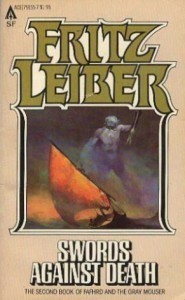 When we move to the descriptions of the Bazaar’s many contents Leiber gives us a masterclass of invention. Then we realize that the many strange and wondrous items in the shop are really moldering bits of filth — so in fact all these images are actually in the Mouser’s imagination, and the shop itself would probably seem to contain different wonders if it had been Fafhrd who had shown up early to the meeting with the wizards, rather than the Mouser.
When we move to the descriptions of the Bazaar’s many contents Leiber gives us a masterclass of invention. Then we realize that the many strange and wondrous items in the shop are really moldering bits of filth — so in fact all these images are actually in the Mouser’s imagination, and the shop itself would probably seem to contain different wonders if it had been Fafhrd who had shown up early to the meeting with the wizards, rather than the Mouser.
And how about those wizards? This is really the first time that we get a good understanding of who Sheelba and Ningauble really are, how they relate to the Gray Mouser and Fafhrd respectively. Having the wizards give Fafhrd some sorcerous gifts to use against the merchant was a great touch, reinforcing that our heroes are really encountering the weird, dealing with things that are inexplicable and beyond their normal abilities (it also, I suspect, gave D&D a few ideas for its treasure tables). But at the same time the archness, the playfulness of Leiber comes through — the wizards’s very different personalities are funny when contrasted with each other, or the notion of a trans-universe invasion through the utterly banal and innocuous portal of a shopfront (opportunity here for a tongue-and-cheek slap at consumerism as well) . The very best of these stories do that; they balance right on the edge of the playful and the perilous, and that tone conveys so much of the essence of the heroes themselves.

Fritz & Jonquil Leiber, 1937.
Howard: I loved every moment. The comical scenes where the Mouser’s sight is juxtaposed with Fafhrd’s. Or Fafhrd’s interaction with Sheelba and Ningauble when they give him the assignment, particularly the bit where Fafhrd pretend to have misunderstood Ningauble’s meanderings about “this doltish brave man who always follows his scheming uncle’s advice.” Then there are the wondrous moments where the Mouser is wandering the store and glimpsing amazing sights, and, of course, the grand finale, where Fafhrd fights the door keeper and it seems to Mouser, because of the enchantment he’s under, that the two are performing comic theatre.
The pacing is perfect. The prose is perfect. The start and conclusion are perfect (down to the brief glimpse Fafhrd obtains of Sheelba). The events are alternatingly comic, amusing, ironic and exciting, sometimes all at once. This story, far more than “Ill Met in Lankhmar,” should have garnered Leiber that Hugo.
Bill: Hell, it should have garnered him a Nobel, but I suppose real heroes are forever fated to stand apart.
Howard: Hah! Well, next week we’ll look back on what we read, and look forward a little to one more Leiber book, Swords in the Mist.
Howard Andrew Jones's Blog
- Howard Andrew Jones's profile
- 368 followers



